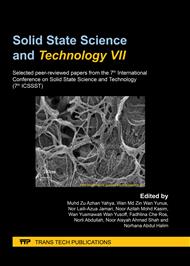p.173
p.180
p.189
p.195
p.202
p.208
p.217
p.227
p.233
Supramolecular Interactions in Aromatic Structures for Non-Optical and Optical Chemosensors of Explosive Chemicals
Abstract:
The scientific investigation based on the molecular design of aromatic compounds for high-performance chemosensor is challenging. This is because their multiplex interactions at the molecular level should be precisely determined before the desired compounds can be successfully used as sensing materials. Herein, we report on the molecular design of chemosensors based on aromatic structures of benzene as the organic motif of benzene-1,3,5-tricarboxamides (BTA), as well as the benzene pyrazole complexes (BPz) side chain, respectively. In the case of BTA, the aromatic benzene acts as the centre to allow the formation of π–π stacking for one-dimensional materials having rod-like arrangements that are stabilized by threefold hydrogen bonding. We found that when nitrate was applied, the rod-like BTA spontaneously formed into a random aggregate due to the deformation of its hydrogen bonding to form inactive nitroso groups for non-optical sensing capability. For the optical chemosensor, the aromatic benzene is decorated as a side-chain of BPz to ensure that cage-shaped molecules make maximum use of their centre providing metal-metal interactions for fluorescence-based sensing materials. In particular, when exposed to benzene, Cu-BPz displayed a blue-shift of its original emission band from 616 to 572 nm (Δ = 44 nm) and emitted bright orange to green emission colours. We also observe a different mode of fluorescence-based sensing materials for Au-BPz, which shows a particular quenching mechanism resulting in 81% loss of its original intensity on benzene exposure to give less red-orange emission (λ = 612 nm). The BTA and BPz synthesized are promising high-performance supramolecular chemosensors based on the non-optical and optical sensing capability of a particular interest analyte.
Info:
Periodical:
Pages:
202-207
Citation:
Online since:
May 2021
Price:
Сopyright:
© 2021 Trans Tech Publications Ltd. All Rights Reserved
Share:
Citation:


